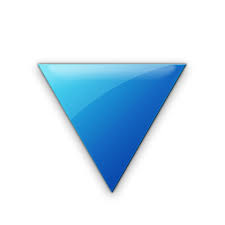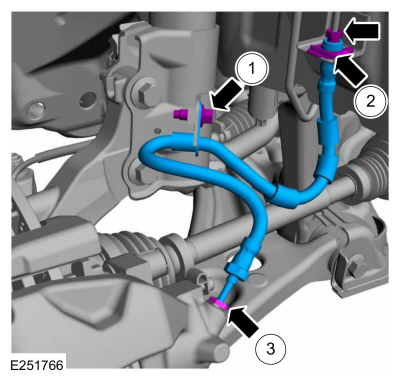Ford Ecosport: Suspension System - General Information / Diagnosis and Testing - Suspension System - AWD
Special Tool(s)

|
Alignment Pins, Subframe 205-870 |

|
Adapter for 205-870 205-870-01 |
Inspection and Verification
-
Verify the customer concern.
-
Visually inspect for obvious signs of mechanical damage.
Visual Inspection Chart
| Mechanical |
|---|
| Tire pressure(s) |
| Wheels and tires |
| Wheel knuckles |
| Tie-rod ends |
| Front suspension lower arm ball joints |
| Front suspension lower arm bushings |
| Front strut and spring assemblies |
| Front stabilizer bar and connecting links |
| Rear springs |
| Rear shock absorbers |
| Rear suspension lower arm ball joints |
| Rear suspension lower arm bushings |
| Rear stabilizer bar and connecting links |
| Rear suspension upper arm ball joints |
| Rear suspension upper arm bushings |
| Rear suspension beam axle and bushings |
-
If an obvious cause for an observed or reported concern is
found, correct the cause (if possible) before proceeding to the next
step.
-
If the cause is not visually evident, verify the symptom and refer to the Symptom Chart.
Symptom Chart
| Symptom | Possible Sources | Action |
|---|---|---|
|
|
|
|
|
|
|
|
|
|
|
|
|
|
|
|
|
|
|
|
|
|
|
|
|
|
|
|
|
|
|
|
|
|
|
|
|
|
|
|
|
|
|
|
|
|
|
|
|
|
|
|
|
|
|
|
|
|
|
|
|
|
|
|
|
|
|
|
|
|
|
|
|
|
|
|
|
|
|
|
|
|
|
|
|
|
|
|
|
|
|
|
|
|
|
|
|
|
|
|
|
|
|
|
|
|
|
|
|
|
|
|
|
|
|
|
|
|
|
|
|
|
|
|
|
|
|
|
|
|
|
|
|
|
|
|
|
Pinpoint Tests
 PINPOINT TEST A: DRIFT LEFT OR RIGHT
PINPOINT TEST A: DRIFT LEFT OR RIGHT|
Possible Sources
NOTE: The following conditions must be met when evaluating the vehicle. NOTE: The tire swapping procedures are for bi-directional rotating tires only. |
||||
| A1 SWAP THE FRONT WHEEL AND TIRE ASSEMBLIES | ||||
Does the vehicle drift?
|
||||
| A2 SWAP THE REAR WHEEL AND TIRE ASSEMBLIES | ||||
Does the vehicle drift?
|
||||
| A3 SWAP THE LEFT-HAND WHEEL AND TIRE ASSEMBLIES | ||||
Does the vehicle drift?
|
||||
| A4 SWAP THE RIGHT-HAND WHEEL AND TIRE ASSEMBLIES | ||||
Does the vehicle drift?
|
||||
| A5 SWAP THE FRONT LEFT-HAND WHEEL AND TIRE ASSEMBLY | ||||
Does the vehicle drift?
|
||||
| A6 SWAP THE FRONT RIGHT-HAND WHEEL AND TIRE ASSEMBLY | ||||
Does the vehicle drift?
|
||||
| A7 INSTALL NEW TIRES | ||||
|
NOTE: Install new tires only once.
Does the vehicle drift?
|
 PINPOINT TEST B: EXCESSIVE NOISE
PINPOINT TEST B: EXCESSIVE NOISE|
Possible Sources
|
||||
| B1 INSPECT ALL STRUT AND SPRING ASSEMBLY AND SHOCK ABSORBER MOUNTING BOLTS AND NUTS | ||||
Are the mounting bolts or nuts loose or broken?
|
||||
| B2 INSPECT THE STRUT AND SPRING ASSEMBLIES AND SHOCK ABSORBERS FOR LEAKS | ||||
Are the struts or shock absorbers leaking?
|
||||
| B3 INSPECT THE SPRINGS AND STABILIZER BAR(S) | ||||
Are the springs or stabilizer bar(s) damaged?
|
||||
| B4 INSPECT THE SUSPENSION BUSHINGS | ||||
Are the bushings worn or damaged?
|
||||
| B5 INSPECT THE SUSPENSION LOWER/UPPER ARM BALL JOINTS | ||||
Is the lower/upper arm ball joint or gaiter damaged?
|
||||
| B6 INSPECT THE WHEEL BEARINGS | ||||
Are the wheel bearings damaged?
|
||||
| B7 INSPECT THE WHEELS AND TIRES | ||||
Is there uneven tire wear?
|
||||
| B8 INSPECT THE STRUT AND SPRING ASSEMBLY AND REAR SUSPENSION SPRING INTERFACE | ||||
Is the concern still evident?
|
||||
| B9 INSPECT THE STRUT AND SPRING ASSEMBLIES AND SHOCK ABSORBER COMPONENTS | ||||
Are any of the strut and spring assemblies or shock absorber components damaged?
|
||||
| B10 CARRY OUT A ROAD TEST | ||||
Is the concern still evident?
|
Component Tests
Raise and support the vehicle.
REFER to: Jacking and Lifting - Overview (100-02 Jacking and Lifting, Description and Operation).
Ball Joint Inspection
-
Firmly grasp the outer end of the suspension lower/upper
arm and try to move it up and down, watching and feeling for any
movement. Free movement will usually be accompanied by an audible
"click''. There should be no free movement.
-
If there is any free movement install a new lower/upper arm.REFER to:
Lower Arm (204-01 Front Suspension, Removal and Installation),
Upper Arm (204-02B Rear Suspension - AWD, Removal and Installation),
-
If a new lower/upper arm is installed it will be necessary to check and adjust the front wheel alignment.
Strut or Shock Absorber Inspection
NOTE: Inspect the struts or shock absorber for signs of oil weepage or leaks. Make sure that the oil is not from another source.
Weepage:
- deposits a thin film of oil on the strut and spring assembly or shock absorber.
- is normally noticed due to a collection of dust on the strut and spring assembly or shock absorber.
- occurs during the normal running-in period of 4800 - 8050 km. After this period no new signs of oil should be visible.
- does not require new struts or shock absorbers to be installed.
Leakage:
- covers the entire strut and spring assembly or shock absorber with oil.
- will drip oil onto the surrounding suspension components.
- requires new struts or shock absorbers to be installed.
Strut or Shock Absorber Testing
NOTE: Struts or shock absorbers must be tested in the vertical position.
-
Remove both strut and spring assemblies or shock absorbers. The piston rods should extend.
-
Disassemble the strut and spring assemblies.
REFER to: Front Strut and Spring Assembly (204-01 Front Suspension, Disassembly and Assembly).
-
Disassemble the strut and spring assemblies.
-
Compress the piston rods. Both piston rods should offer the same resistance when compressing.
-
Compress and release the piston rods. The piston rods should extent equally.
-
Compress and pull the piston rod in the vertical
position. Feel if the resistance force at the point of direction
change-over is perceptible without a lag. If a lag is perceptible it is
an indication of damper valve damage and new struts or shock absorbers
must be installed. REFER to:
Front Strut and Spring Assembly (204-01 Front Suspension, Removal and Installation),
Rear Shock Absorber (204-02B Rear Suspension - AWD, Removal and Installation).
 Diagnosis and Testing - Suspension System - FWD
Diagnosis and Testing - Suspension System - FWD
Preliminary Inspection
Road test the vehicle.
If any suspension alignment or ride height concerns are present, REFER to Symptom Chart: Suspension System...
 General Procedures - Front Toe Adjustment
General Procedures - Front Toe Adjustment
Special Tool(s) /
General Equipment
Wheel Alignment System
Adjustment
NOTE:
Make sure that the vehicle is standing on a level surface...
Other information:
Ford Ecosport 2014-2025 Service and Repair Manual: Removal and Installation - Selector Lever Cable - 6-Speed Automatic Transmission – 6F35
Removal With the vehicle in N , position it on a hoist. Refer to: Jacking and Lifting - Overview (100-02 Jacking and Lifting, Description and Operation). Remove the air cleaner. Refer to: Air Cleaner (303-12C Intake Air Distribution and Filtering - 2...
Ford Ecosport 2014-2025 Service and Repair Manual: Diagnosis and Testing - Pinpoint Test - DTC: R, Vehicles With: Rear Seat Side Airbag
B11CF:11, B11CF:12, B11CF:13, B11CF:1A Refer to Wiring Diagrams Cell 46 for schematic and connector information. Normal Operation and Fault Conditions The RCM continuously monitors the passenger airbag adaptive canister vent circuits for the following faults: Resistance out of range Unexpected voltage Short to ground Faulted passenger airbag adapt..

 PINPOINT TEST A: DRIFT LEFT OR RIGHT
PINPOINT TEST A: DRIFT LEFT OR RIGHT WARNING:
To avoid personal injury due to the loss of vehicle
control, the inspection should be carried out by two people to maintain
safe driving conditions. Adequate grip should always be maintained on
the steering wheel. Failure to follow these instructions may result in
personal injury.
WARNING:
To avoid personal injury due to the loss of vehicle
control, the inspection should be carried out by two people to maintain
safe driving conditions. Adequate grip should always be maintained on
the steering wheel. Failure to follow these instructions may result in
personal injury.
